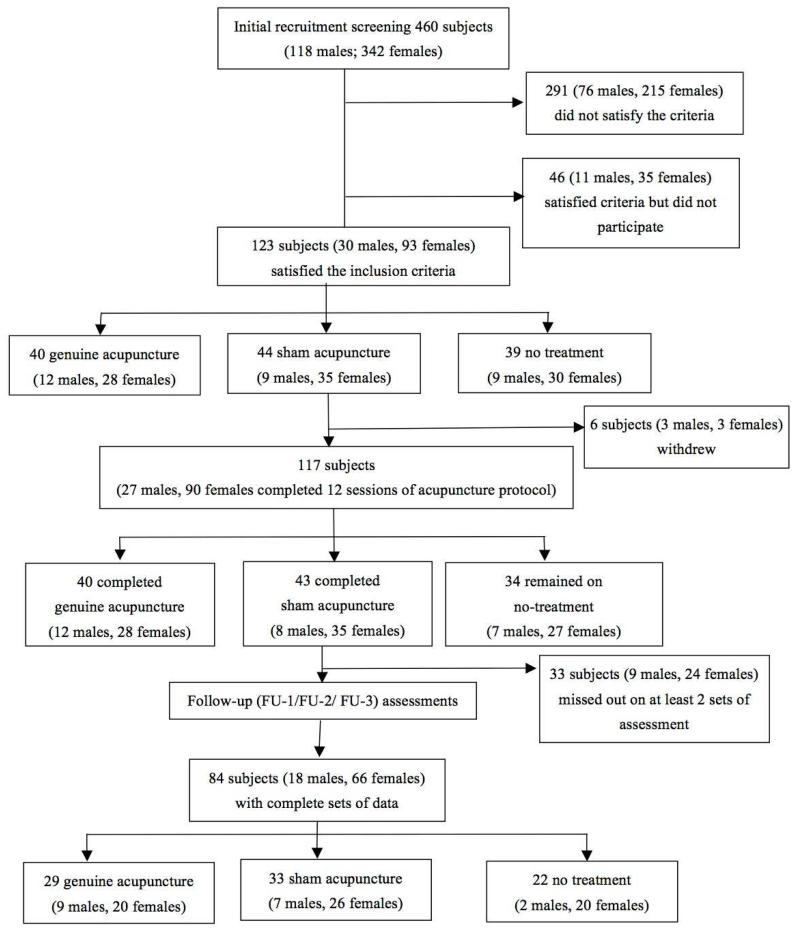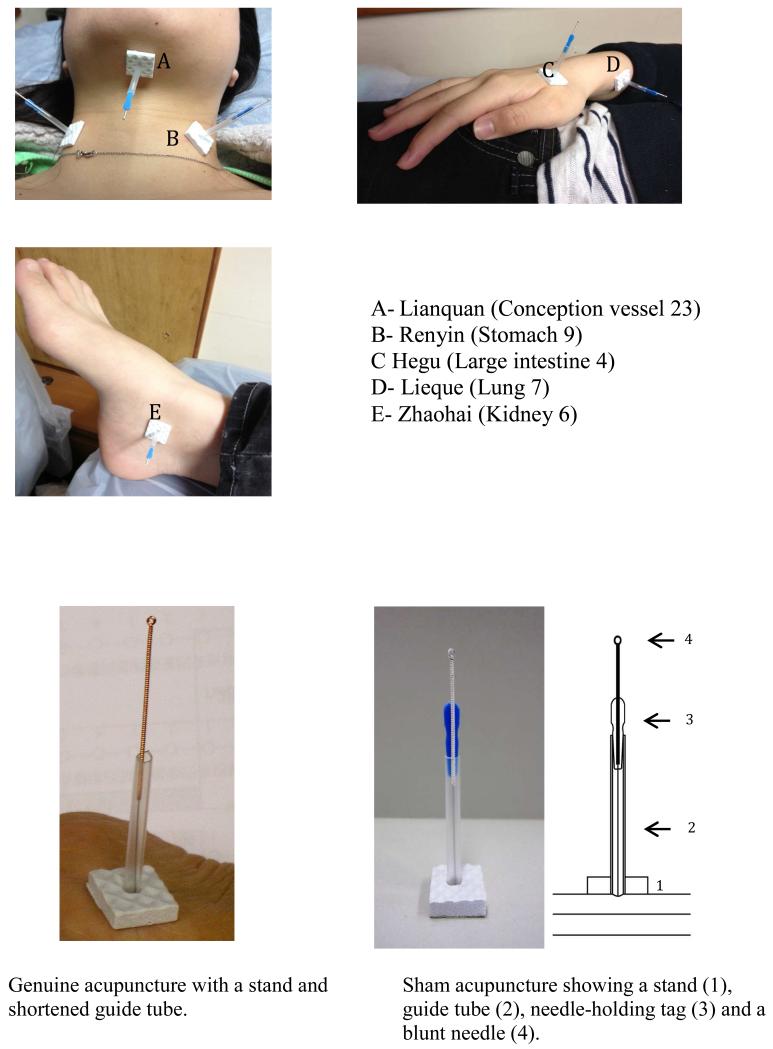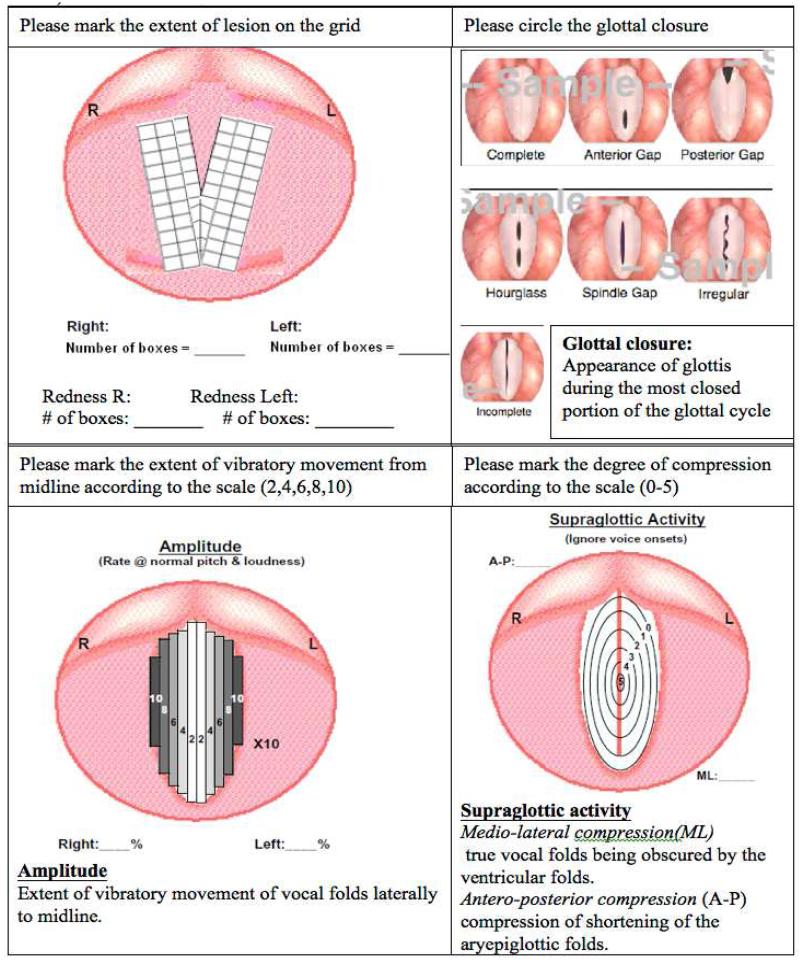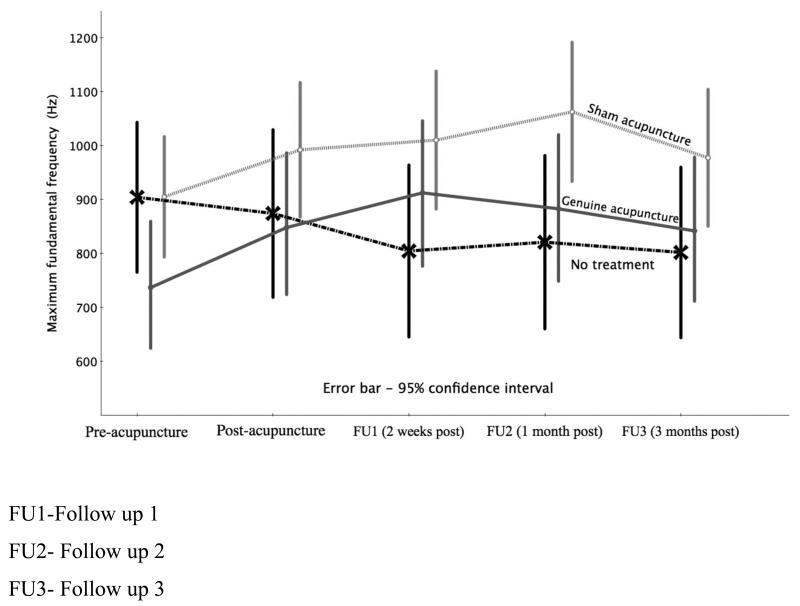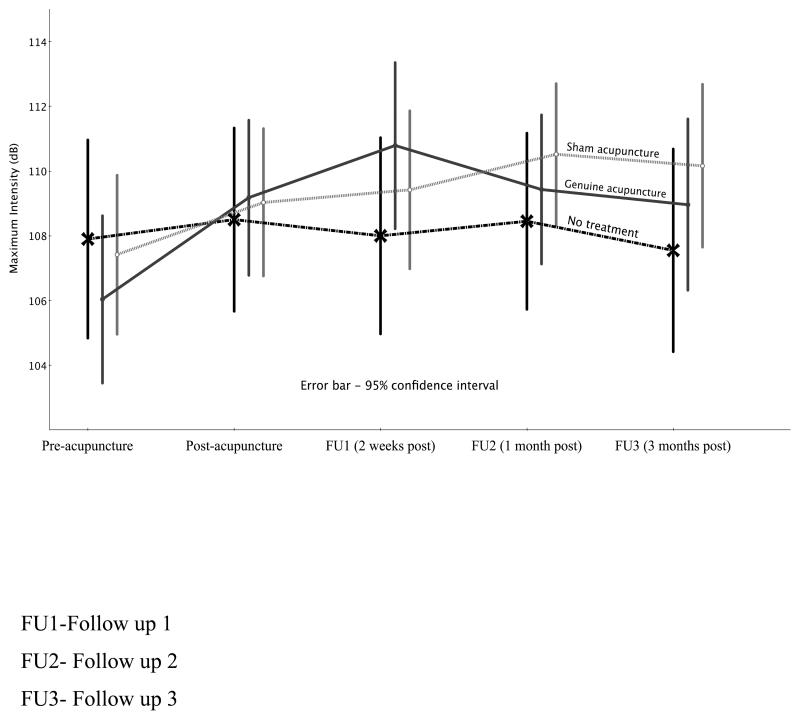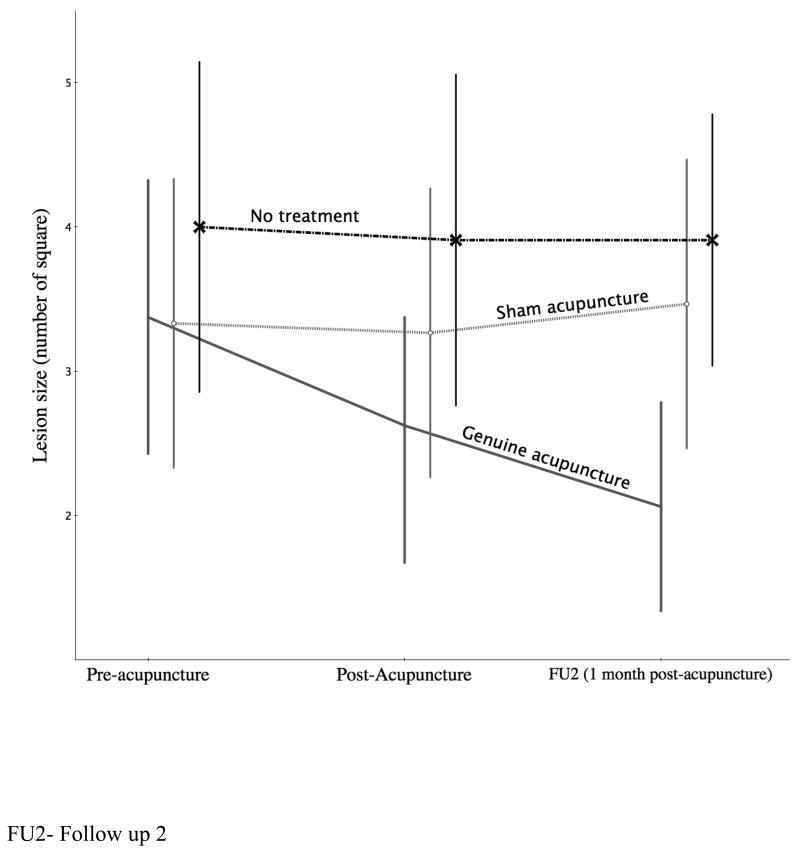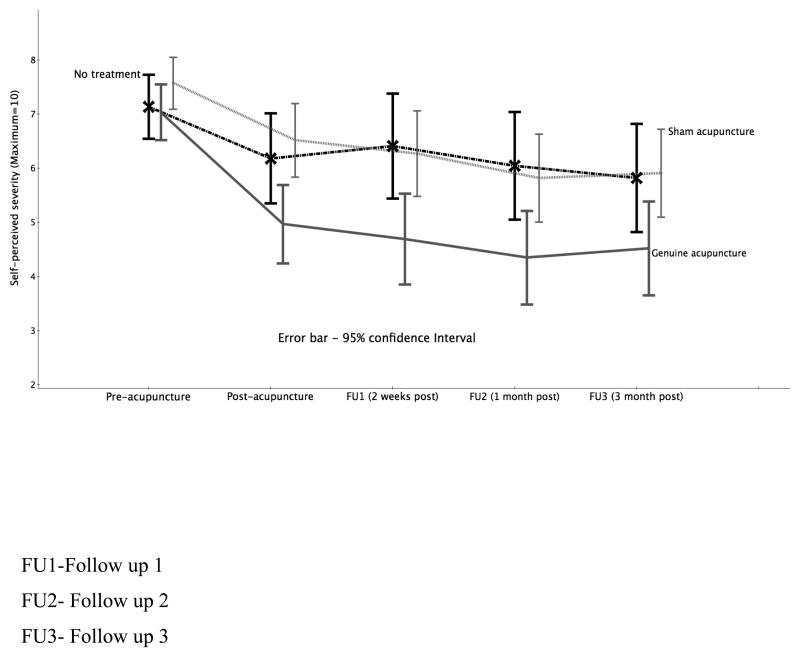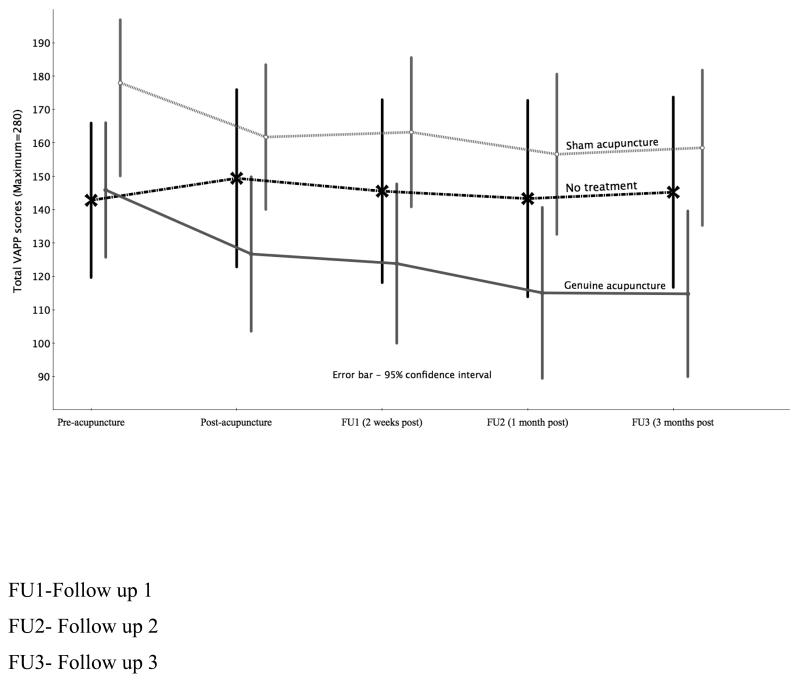Abstract
Objective
To investigate the effectiveness of acupuncture in treating phonotraumatic vocal fold lesions.
Study Design/Methods
A total of 123 dysphonic individuals with benign vocal pathologies were recruited. They were given either genuine acupuncture (N=40), sham acupuncture (N=44) or a no-treatment (N=39) for six weeks (two 30-minute sessions per week). The genuine acupuncture group received needles puncturing nine voice-related acupoints for 30 minutes, two times a week for six weeks; while the sham acupuncture group received blunted needles stimulating the skin surface of the nine acupoints for the same frequency and duration. The no-treatment group did not receive any intervention but attended just the assessment sessions. One hundred and seventeen subjects completed the study (genuine acupuncture=40; sham acupuncture=43, and no-treatment=34), but only 84 of them had a complete set of vocal functions and quality of life measures (genuine acupuncture=29; sham acupuncture=33, and no-treatment=22), and 42 of them with a complete set of endoscopic data (genuine acupuncture=16; sham acupuncture=15 and no-treatment=11).
Results
Significant improvement in vocal function, as indicated by the maximum fundamental frequency produced, and also perceived quality of life, were found in both the genuine and sham acupuncture groups, but not in the no-treatment group. Structural (morphological) improvements were, however, only noticed in the genuine acupuncture group, which demonstrated a significant reduction in the size of the vocal fold lesions.
Conclusions
The findings showed that acupuncture of voice-related acupoints could bring about improvement in vocal function and healing of vocal fold lesions.
Keywords: dysphonia, therapy efficacy, alternative treatment
INTRODUCTION
Dysphonia affects around 6% 1,2 of the population. Specific populations that have a high demand on voice use (e.g. teachers) show higher prevalence (9%3 to 11%4). Some of the most common causes of dysphonia include vocal nodules, polyps or chronic (or non-infectious) laryngitis 5,6. Contemporary treatment recommendations include behavioral voice therapy that aims to re-adjust voicing mechanics and allows the vocal pathologies to resolve through a wound healing process is the current treatment option7,8. Surgery may be needed in some recalcitrant cases9-11 but follow-up behavioral voice therapy12,13 is required. It is not difficult to understand that some individuals may find the invasiveness of surgery and the extended period required for behavioral change not a viable option for them. Furthermore, it is noted as much as 10-20% of patients with dysphonia did not improve with such treatment régime at all 13-15.
There has been an increasing trend in people seeking alternative treatment, like acupuncture, besides western traditional medicine 16. Surveys have shown that 4-9% of the population in western societies have used acupuncture17-19. Numerous anecdotal reports and experimental studies on the usefulness of acupuncture in treating voice problems can be found in the literature 20-24. Nevertheless, these studies often lack details on the methodology, and objective outcome measures. Therefore, the reported effectiveness of these studies is questionable, as placebo effect cannot be excluded 25.
Yiu et al. 26 reported the first randomized control prospective study on the effectiveness of acupuncture in treating phonotraumatic dysphonia. These subjects were randomly assigned to either a treatment group that received acupuncture at voice-related acupoints (Renyin (Stomach-9), Lieque (Lung-7) and Zhaohai (Kidney-6)) or a placebo group that received acupuncture at non-voice-related acupoints (Houxi (Small Intestine-3) and Kunlun (Bladder-60)). Both groups received 10 sessions of 30-minute acupuncture over a 20-day period. Results from 24 subjects who completed treatment and assessments showed that acupuncture at the voice-related acupoints brought about significantly greater improvements in the vocal function (maximum fundamental frequency produced), voice quality severity (breathiness and roughness), and quality of life in terms of voice-related activity and participation 27 when compared to those with needling (putting needle into the body by puncturing the skin) at the non-voice-related acupoints.
Gaps in the data
The published data on the use of acupuncture in voice disorder are limited by a number of methodological and interpretive concerns. First, majority of these reports did not use objective outcome measures to document treatment outcomes. Rather, the outcome measures used were based on the subjective un-blinded evaluation of severity of vocal fold pathologies and/or voice quality. Therefore, Hawthorne effects and possible biases of the evaluators could not be excluded. Second, control data were lacking in most of these studies. Thus, it is difficult to conclude that improvements reported were solely the effect of acupuncture, as placebo effects are not uncommon in acupuncture therapy25. Third, treatment procedures in these reports were not standardized. Many of these acupuncture studies employed individualized acupoints and treatment schedule. Such approach renders study replication and generalization of results nearly impossible. Although the study by Yiu et al. 26 appeared to be free of these three limitations, the valid sample size was relatively small (N=24). Therefore, there is a need to validate this potential effective alternative treatment option for treating dysphonia with phonotraumatic vocal pathologies. The present study aimed to investigate the effectiveness of a standard acupuncture protocol for phonotraumatic vocal fold injury using a prospective, randomized, placebo-controlled clinical study design.
METHODS
Participants
A total of 123 subjects (30 males, 93 females), with vocal nodules, polyps or chronic laryngitis, (as diagnosed by laryngologists), were recruited through the University of Hong Kong Voice Clinic from March 2007 to November 2012. Participants only between the ages of 20 to 56 years old were included so as to eliminate any voice deviations due to puberty and especially aging (e.g. presbylarynx). The participants had no knowledge of how acupuncture would be conducted, no cardiovascular, neurological or respiratory disorders and did not receive any medication at the time of the study. None of the subjects had voice therapy before or was given any voice therapy during the time of the study. Informed consents were obtained with information sheet and verbal explanation regarding the procedure and the allocation protocol were provided. Participants were randomly assigned to a genuine, sham, or no-treatment group. In the public health system of Hong Kong, the waiting time for voice therapy appointment at the time of the study generally varied from 3 to 6 months upon diagnosis and referral by otolaryngologists. Therefore, the no-treatment group was given the standard waiting time before admitted for voice therapy in the public service system. On completion of the assessment protocol, the participants in the no-treatment group were given an option of genuine acupuncture as a treatment, and the participants in the sham acupuncture group were given the options of genuine acupuncture or voice therapy. Six participants withdrew from the study due to inability to attend the session on a regular basis, and the remaining 117 participants completed the full protocol with pre- and post-treatment measurements as detailed below. However, 33 of the subjects did not return for at least two of the follow-up assessments, therefore, leaving 84 participants in the final analyses if the complete data set. Figure 1 lists the flow chart of the protocol.
Figure 1. Participants flow through the trial.
Outcome measures
Three primary outcome measures were used
a) Vocal function using the voice range profile 28,29
The ability to produce different loudness and pitch was assessed by using a Swell Real-time DSP Version 2 Phonetograph (Phog 2.0, AB Nyvalla DSP, Stockholm). The procedure was carried out in a sound-treated room with voice samples captured using a head mounted condenser microphone (AKG Acoustics C420, Vienna) at a microphone-to-mouth distance of 5 cm and angle of 45 degrees 28.
Each subject produced the lower intensity contour first by sustaining the vowel /a/ at the scale C4 (261.6 Hz) by imitating a tone generated by the Phog 2.0 system. The intensity of that particular pitch was gradually decreased until the lowest intensity was produced. This step was repeated for every semitone down and then up the piano scale until the participant found the pitch too low or too high to produce 30. The upper intensity contour was obtained similarly with the participant gradually increased the loudness until the loudest voice was produced. The maximum pitch/fundamental frequency and intensity obtained with this procedure have been found to be sensitive outcome measures that reflect changes over time following voice therapy28,29.
b) Size of vocal fold lesion using laryngoscopy31
Vocal fold examinations were conducted using rigid endoscopy (Storz Model Xenon 300, Storz Telecam Model SLII, Karl Storz GmbH & Co. KG, Tuttlingen) with the images recorded using the Corel Video Studio Pro X2 (Corel Corp., Ottawa). Trans-oral laryngo-endoscopy was carried out without using any local anesthetic to avoid possible effects on the vibratory function of the vocal folds. The participants produced a sustained /i/ with their tongue protruded at a comfortable pitch level for at least five seconds. Full view of the glottis and the vocal folds were captured and recorded using strobe light.
c) Quality of life questionnaire
The impact of voice disorders on the participants’ daily communication, job, social communication, and emotional aspects was assessed using the Voice Activity and Participation Profile (VAPP) 32, which is a 28-item questionnaire completed by the participants.
Procedures
a) Assessment schedule
Pre-treatment (PRE) baseline measures were taken about an hour prior to the first acupuncture treatment. Second set of measures were taken two hours after the last acupuncture session (6th week; post-treatment [POST]), then followed by three assessments, conducted 14 days (8th week follow up: FU1), 30 days (10th week follow up: FU2) and 90 days (19th week follow up: FU3) post-treatment. Participants in the no-treatment group were assessed on the day of enrolment, and at the 6th, 8th, 10th and 19th week of their participation. The assessors who undertook the assessments were unaware of the treatment the participants received. The sequence of assessment tasks was randomized to minimize any possible task order effects.
b) Acupuncture protocol
Participants were randomly assigned to either a genuine acupuncture, sham acupuncture (needles not puncturing the skin) or a no-treatment group. Genuine or sham acupuncture consisted of 12 sessions over six weeks. All acupuncture treatments took place in a quiet clinic room and were conducted by qualified acupuncturists. Three acupuncturists, each with at least two years of experience in acupuncture, conducted the acupuncture. The three acupuncturists were given three hours of training and practice in needling the specific acupoints described below.
All participants lay on a couch and received needling at nine acupoints. These acupoints, namely, two Hegu and two Lieque points at the wrists, one Lianquan and two Renying points in the neck and two Zhaohai points at the ankles (Figure 2), were based on the protocol used in the study by Yiu et al 26. Disposable stainless steel needles (0.25 mm diameter, 25 mm long with a 25 mm extended handle) were used (see Figure 2). Each needle was inserted through a 25 mm long guide tube (Hua Tuo Brand, Suzhou Medical Appliance, Suzhou) with one end attached to an opening in the center of a foam board (1 cm × 1 cm) that was taped to the skin surface of each acupoints (Figure 2).
Figure 2. Needling position and needle design.
The needling depth is typically about 13 mm for Zhaohai, Hegu and Lianquan and 5-8 mm for Lieque and Renyin acupoints 33. Stimulation was applied by twirling the needles once every five minutes for 30 minutes. For the sham acupuncture group, blunted acupuncture needles were used 34 and the needles did not penetrate the skin but instead the acupuncturists twirled the needles to exert pressure on the skin surface (see Figure 2). Since all the subjects had no prior experience of acupuncture, it is reasonable to expect that the participant could not tell whether they had genuine acupuncture (acupoint twirling) or the sham acupuncture (skin surface twirling).
Data Analysis
Bonferroni adjustment was used minimize the chances of committing a Type I error (false-positive results) when multiple pair-wise comparisons were made. This was carried out by dividing the p value by the number of comparison tests.
a) Voice range profile
The maximum fundamental frequency and maximum intensity were extracted for each participant to represent the maximum vocal function measures.
b) Size of vocal fold lesion
A modified version of the Stroboscopic Evaluation Rating Form (SERF) by Poburka35 was used. The mass of lesion was estimated by counting the number of squares (see Figure 3) the lesion occupied on each side of vocal folds. Since a number of participants were unable to tolerate the rigid endoscopy without local anesthesia at some stage of the data collection, the recordings were reviewed and found only 62 of the 126 participants had a full set of laryngoscopic recordings from the PRE, POST and FU2 time points. Therefore, a total of 186 videos (62 participants × 3 time points) were evaluated by three judges (all speech language pathologists), each had at least 10 years of experience in carrying out laryngoscopic procedure and evaluating laryngoscopic images. The order of the three recordings for each participant was randomly presented for evaluation. The judges were not aware of the diagnosis, type of acupuncture (genuine or sham or control) received or the time point that the video images were taken. The three judges watched the video samples together but rated the lesion size independently. They then compared their ratings and agreed on a consensus rating for each sample. Reliability measures of the three judges, which were reported in another study 36, were high. Intra-class correlation coefficients in rating the lesion size before arriving at the consensus ratings were 0.81 and 0.75 (p=0.001) for the right and left vocal fold lesion respectively.
Figure 3. Stroboscopic Assessment From adapted from Poburka (1999).
c) Quality of life
The self-perceived severity score and the total VAPP scores were calculated for all participants across time.
RESULTS
All baseline measurements were not significantly different among the three groups of participants (Bonferroni adjustment = 0.05/4 = 0.0125 since four measurements were compared; maximum fundamental frequency (Max F0), F=2.49, p=0.09; maximum intensity, F=0.51, p=0.61; lesion size, F=0.48, p=0.62; self-perceived severity, F=1.6, p=0.21; Total VAPP score (F=4.26, p=0.02).
Two-way ANOVA using Huynh-Feldt tests with adjusted degrees of freedom were used as no normality assumption was required 37. When significant results were found in the main effect of Time or the interaction effect, planned contrasts were carried out to determine which time point was different from the PRE baseline.
a) Vocal function (Voice range profile)
Figure 4 shows the Max F0 produced over time. Huynh-Feldt tests showed no significant main effect of Time (F = 2.01, df = 2.84, p = 0.12, partial eta square=0.03, observed power=0.50) or Group (F = 2.09, df = 2, p = 0.13, partial eta square=0.05, observed power=0.42). A significant Time × Group interaction effect was found (F = 2.39, df = 5.69, p = 0.03, partial eta square=0.06, observed power=0.79). Figure 4 showed that both the genuine and sham acupuncture groups have improved Max F0 over time while the no-treatment group showed a slight decrease over time. Planned contrasts showed that FU1 (F=4.35, df=1, p=0.02) and FU2 (F=3.90, df=1, p=0.02) demonstrated significantly higher Max F0 when compared to that of PRE, while no significant differences were found at the POST and FU3 time points (p>0.09).
Figure 4. Change of maximum fundamental frequency over time.
Figure 5 shows the maximum intensity produced over time. A significant main effect of Time was found (F = 4.95, df = 3.94, p = 0.001, partial eta square=0.06, observed power=0.96). Planned contrast of Time showed that the mean maximum intensity produced at all the time points were significantly higher than that at the PRE (p<0.015). No significant differences were found with the main effect of Group (F = 0.28, df = 2, p = 0.76, partial eta square=0.007, observed power=0.09) or the Time × Group interaction effect (F = 1.69, df = 7.88, p = 0.1, partial eta square=0.04, observed power=0.35). This indicated that the overall maximum intensity produced by the three groups increased over time.
Figure 5. Change of maximum intensity produced over time.
b) Lesion size - laryngoscopic evaluation
A number of image samples that were not analyzable or did not receive a consensus rating were excluded from the final analysis. Only 42 participants with a complete analyzable set of data are reported here. Five (12%) of them were male, and 37 (88%) of them were female. The mean age of this subject group was 38.26 years (20-56 years, SD = 10.40). Thirty-one (73.8%) of them were diagnosed with bilateral nodules. Four (9.5%) of them had vocal polyps; and seven (16.7%) were diagnosed with either chronic laryngitis or thickened vocal folds. Sixteen of them were in the genuine acupuncture group, 15 in the sham acupuncture group and 11 in the no-treatment group.
Figure 6 shows the mean lesion size over the three time points. Significant main effect of Time (F = 3.18 df = 2, p = 0.047, partial eta square=0.075, observed power=0.59) was found with planned contrasts showed the difference lied between the FU2 and PRE time points (F=5.29, df=1, p=0.027) but not between the POST and PRE time points (F=2.99, df=1, p=0.09). There was no significant Group effect (F =1.99, df = 2, p = 0.15, partial eta square=0.09, observed power=0.39). Significant Time × Group interaction effect (F = 3.77 df = 4.0, p = 0.007, partial eta square=0.16, observed power=0.87) was also found. Planned contrast showed the significant difference also lied between the FU2 and PRE time points (F=6.63, df=1, p=0.003) but not between the POST and PRE time points (F=1.79, df=1, p=0.18). Figure 6 shows clearly that the genuine acupucnutte goup showed significant recuction in the lesion size over time when compared to the other two groups.
Figure 6. Change of lesion size over time.
c) Quality of life
Figure 7 shows the mean self-perceived severity of the participants across time. A significant main effect of Time (F = 24.59, df = 3.42, p < 0.0001, partial eta square=0.23, observed power=0.99) was found. Planned contrasts showed that the POST, FU1, FU2 and FU3 were all significantly lower than the PRE (p<0.0001). The main effect of Group (F = 5.32, df = 2, p = 0.007, partial eta square=0.12, observed power=0.83) was also significant. Post-hoc Least Significant Difference (LSD) indicated that significant differences were found between the genuine acupuncture and the no treatment groups (mean difference=1.2 [out of a maximum score of 10], p = 0.01) as well as between the genuine and sham acupuncture groups (mean difference=1.3, p = 0.003). No significant difference was found between the no-treatment and sham acupuncture groups (mean difference=0.1, p = 0.83). No significant Time × Group interaction effect (F = 1.61, df = 6.85, p = 0.13, partial eta square=0.038, observed power=0.66) was found.
Figure 7. Change of self-perceived severity over time.
Figure 8 shows the mean total VAPP score across the time points. A significant main effect of Time (F = 5.17, df = 2.97, p = 0.002, partial eta square=0.06, observed power=0.92) was found. Planned contrasts showed that the overall mean total VAPP scores at POST, FU1, FU2 and FU3 were all significant lower than that at the PRE (p<0.04) time point. Main effect of Group (F = 3.25, df = 2, p = 0.04, partial eta square=0.07, observed power=0.60) was also found to be significant. Post-hoc Least Significant Difference test showed only the genuine and sham acupuncture groups were significantly different (mean difference=38.35 [out of a maximum of 280], p=0.01). No significant Time × Group interaction effect (F=1.64, df = 5.93, p = 0.41, partial eta square=0.04, observed power=0.62) was found.
Figure 8. Total VAPP (Voice Activity & Participation Profile) score over time.
DISCUSSIONS
Current treatment options for phonotraumatic vocal fold pathologies include conservative voice therapy and surgery 10,13. In rare cases when surgery is the recommended option when conservative voice therapy fails, it is not difficult to understand that many patients would look for alternative treatment options because of the invasiveness and risk associated with surgery. Many anecdotal reports and more recently randomized trials 26 have shown the acupuncture can effectively treat this problem.
This randomized control study showed that acupuncture on voice-related acupoints is effective in improving the vocal functions, as indicated by the main interaction (Time × Group) effect of maximum fundamental frequency. It can be seen that both the genuine and sham acupuncture groups demonstrated significant improvements following acupuncture (Figure 4). The maximum intensity (Figure 5) data showed similar trend although the main interaction effect was not statistically significant. One might question whether there was the Hawthorne effect in vocal function (maximum F0) demonstrated by the sham acupuncture group. Admittedly, this effect could not be discounted, but the lack of similar finding in the maximum intensity suggests that this factor might have only played a small role, if any, in facilitating vocal function improvement over time.
Both the self-perceived severity and total VAPP score in the quality of life measures showed significant Time effect but no interaction effect. Since these two outcome measures relied on the perception of the subjective evaluation of the participants, the results suggested that were possible placebo effects. Interestingly, the data on the changes of lesion size show only significant benefit in the genuine acupuncture group. The sham acupuncture group did not show a similar improvement in the lesion size reduction as in their vocal function. Although the sample size for the lesion size analysis was much smaller when compared to that in the other outcome measures, the fact that the significant finding had a large effect size (partial eta square=0.16, observed power=0.87) suggested that acupuncture had a significant effect in reducing the size of vocal fold lesions over time when compared to the sham acupuncture.
There is a finding from the present study that cannot be answered with the available data. The vocal function, in terms of maximum fundamental frequency produced, improved significantly following both genuine and sham acupuncture. One might contend that this was probably due to placebo or Hawthorne effects. In an earlier report, Yiu et al26 reported a significant improvement in vocal function (maximum fundamental frequency) also in a group of dysphonic subjects (N=12) with genuine acupuncture at the voice-related acupoints. However, no such improvement was found with needling at non-acupoints in another group with dysphonia (N=12). If placebo effect were expected in the needling procedure, one would have expected improved vocal function in the group that received needling at the non-acupoint as well. Undoubtedly, further study which will include a trial with genuine acupuncture (on voice-related acupoints), sham acupuncture (not penetrating the acupoints) and “needling” of non-voice related acupoints will be needed to answer these questions. Based on the current evidence, we hypothesize that merely stimulation on the skin surface of the acupoints would facilitate an improvement in vocal function at some level.
Although the sample size was much smaller when it came to the analysis stage due to missing data set, the effect size of the various outcome measures were relatively large. The findings from the present study support that acupuncture could be a management option. We would like to recommend that acupuncture be considered as one of the treatment options for treating chronic phonotraumatic vocal fold lesions. However, it should be noted that the improvement gained in vocal function (maximum frequency, see Figure 6) over time was not maintained by three months post-acupuncture. This brings out the possibility that without voice therapy to change the phonatory behavior of the individuals, there is a risk of difficulty in maintaining the therapeutic effect of acupuncture.
What remains to be answered is whether any physiological explanations are available to account for the underlying mechanism of this wound healing effect and vocal function improvement. In a separate study that investigated the anti-inflammatory effect of acupuncture, a wound-healing hypothesis of acupuncture was proposed. The study found that anti-inflammatory cytokine increased following genuine but not sham acupuncture38. It was concluded that acupuncture enhances the anti-inflammatory effect in vocal fold lesion healing.
There were also a few limitations with this study. First, the attrition rate and the missing data at some stages of the data collection did not allow us to have a large enough sample size to draw definitive conclusion. For example, the number of subjects in each type of vocal pathologies within each subject groups was small. Second, the study assessed the subjects for up to three months post-treatment. The data indicated that the improvement could not be maintained beyond that time point. Further studies will be needed to investigate the maintenance effect of acupuncture. Third, the present study did not include control groups with surgery or behavior voice therapy. It would be necessary to compare the effect of acupuncture, surgery and behavior voice therapy in order to come up with an evidence-based recommendation for the treatment of benign vocal pathologies.
CONCLUSION
The findings from the study showed that acupuncture of voice-related acupoints could bring about improvement in vocal function and healing of vocal fold lesions. Further research investigation into this as a possible treatment for phonotraumatic lesions is warranted.
ACKNOWLEDGMENT
The study was supported in part by grants awarded by National Center for Complementary and Alternative Medicine, National Institute of Health (#R21 AT003879-01) and the Hong Kong Research Grant Council (HKU782509-2009).
The experimental protocol was approved by the Institutional Review Board of The University of Hong Kong/ Hospital Authority Hong Kong West Cluster/ (IRB# UW 07/004).
Footnotes
Publisher's Disclaimer: This is a PDF file of an unedited manuscript that has been accepted for publication. As a service to our customers we are providing this early version of the manuscript. The manuscript will undergo copyediting, typesetting, and review of the resulting proof before it is published in its final citable form. Please note that during the production process errors may be discovered which could affect the content, and all legal disclaimers that apply to the journal pertain.
Conflict of Interest: None
REFERENCES
- 1.Roy N, Merrill RM, Thibeault S, Gray SD, Smith EM. Voice disorders in teachers and the general population: Effects on work performance, attendance, and future career choices. J Speech Lang Hear Res. 2004;47:542–551. doi: 10.1044/1092-4388(2004/042). [DOI] [PubMed] [Google Scholar]
- 2.Roy N, Merrill RM, Gray SD, Smith EM. Voice disorders in the general population: prevalence, risk factors, and occupational impact. Laryngoscope. 2005;115:1988–1995. doi: 10.1097/01.mlg.0000179174.32345.41. [DOI] [PubMed] [Google Scholar]
- 3.Angelillo M, Di Maio G, Costa G, Angelillo N, Barillari U. Prevalence of occupational voice disorders in teachers. J Prev Med Hyg. 2009;50:26–32. [PubMed] [Google Scholar]
- 4.Roy N, Merrill RM, Thibeault S, Parsa RA, Gray SD, Smith EM. Prevalence of voice disorders in teachers and the general population. J Speech Lang Hear Res. 2004;47:281–293. doi: 10.1044/1092-4388(2004/023). [DOI] [PubMed] [Google Scholar]
- 5.Franco RA, Andrus JG. Common diagnoses and treatments in professional voice users. Otolaryngol Clin North Am. 2007;40:1025–1061. vii. doi: 10.1016/j.otc.2007.05.008. [DOI] [PubMed] [Google Scholar]
- 6.Verdolini K, Rosen C, Branski RC. Classification manual for voice disorders-I. Erlbaum; Mahwah, NJ: 2006. [Google Scholar]
- 7.Nakagawa H, Miyamoto M, Kusuyama T, Mori Y, Fukuda H. Resolution of vocal fold polyps with conservative treatment. J Voice. 2012;26:e107–110. doi: 10.1016/j.jvoice.2011.07.005. [DOI] [PubMed] [Google Scholar]
- 8.Wang CT, Liao LJ, Lai MS, Cheng PW. Comparison of benign lesion regression following vocal fold steroid injection and vocal hygiene education. Laryngoscope. 2014;124:510–515. doi: 10.1002/lary.24328. [DOI] [PubMed] [Google Scholar]
- 9.Pannabacker M. Treatment of Vocal Nodules: Options and Outcomes. Am J Speech Lang Pathol. 1999;8:207–217. [Google Scholar]
- 10.Zeitels SM, Casiano RR, Gardner GM, Hogikyan ND, Koufman JA, Rosen CA. Management of common voice problems: Committee report. Otolaryngol Head Neck Surg. 2002;126:333–348. doi: 10.1067/mhn.2002.123546. [DOI] [PubMed] [Google Scholar]
- 11.Dworkin JP, Meleca RJ. Vocal Pathologies: Diagnosis, Treatment and Case Studies. Singular Publishing; San Diego: 1997. [Google Scholar]
- 12.Rubin JS, Yanagisawa E. Benign vocal fold pathology through the eyes of the laryngologist. In: Rubin JS, Sataloff RT, Korovin GS, editors. Diagnosis and Treatment of Voice Disorders. 2nd ed. Thomson Learning, Inc.; New York: 2003. [Google Scholar]
- 13.Bequignon E, Bach C, Fugain C, et al. Long-term results of surgical treatment of vocal fold nodules. Laryngoscope. 2013;123:1926–1930. doi: 10.1002/lary.23768. [DOI] [PubMed] [Google Scholar]
- 14.Woo P, Casper J, Colton R, Brewer D. Diagnosis and treatment of persistence dysphonia after laryngeal surgery: A retrospective analysis of 62 patients. Laryngoscope. 1994;104 doi: 10.1288/00005537-199409000-00007. [DOI] [PubMed] [Google Scholar]
- 15.Holmberg EB, Hillman RE, Hammarberg B, Sodersten M, Doyle P. Efficacy of a behaviorally based voice therapy protocol for vocal nodules. J Voice. 2001;15:395–412. doi: 10.1016/S0892-1997(01)00041-8. [DOI] [PubMed] [Google Scholar]
- 16.Harris P, Rees R. The prevalence of complementary and alternative medicine use among the general population: a systematic review of the literature. Complement Ther Med. 2000;8:88–96. doi: 10.1054/ctim.2000.0353. [DOI] [PubMed] [Google Scholar]
- 17.Xue CC, Zhang AL, Lin V, Da Costa C, Story DF. Complementary and alternative medicine use in Australia: a national population-based survey. J Altern Complement Med. 2007;13:643–650. doi: 10.1089/acm.2006.6355. [DOI] [PubMed] [Google Scholar]
- 18.Thomas KJ, Nicholl JP, Coleman P. Use and expenditure on complementary medicine in England: a population based survey. Complement Ther Med. 2001;9:2–11. doi: 10.1054/ctim.2000.0407. [DOI] [PubMed] [Google Scholar]
- 19.Barnes PM, Powell-Griner E, McFann K, Nahin RL. Complementary and alternative medicine use among adults: United States, 2002. Seminars in Integrative Medicine. 2004;2:54–71. [PubMed] [Google Scholar]
- 20.Pi J. Acupuncture for 50 singers with thickened vocal cords using Renying and Shuitu. Chinese Acupuncture (In Chinese) 1987;3:17–18. [Google Scholar]
- 21.Chen Y. Acupuncture in treating 56 cases of vocal nodules. (In Chinese). . Jiangsu Chinese Medicine. 2004;25:49. [Google Scholar]
- 22.Xie Q, Yang S. The clinical observation of treating vocal nodule with the integration of acupuncture and Chinese herbal medicine. Chinese journal of integrated traditional and western medicine. 1999;19:245–246. [Google Scholar]
- 23.Yang S. Clinical observations on 109 cases of vocal nodules treated with acupuncture and Chinese drugs. Journal of Traditional Medicine. 2000;20:202–205. [PubMed] [Google Scholar]
- 24.Chu ST, Ye L, Wu YY. Acupoint injection in treating chronic laryngitis: a report of 58 cases. Chinese acupuncture & moxibustion. 1999;2 [Google Scholar]
- 25.Lao L, Ezzo J, Berman BM, Hammerschlag R. Assessing Clinical Efficacy of Acupuncture: Considerations for designing Future Acupuncture. In: Stux G, Hammerschlag R, editors. Clinical Acupuncture: Scientific Basis. Springer; Heidelberg: 2001. pp. 187–210. [Google Scholar]
- 26.Yiu E, Xu JJ, Murry T, et al. A randomized treatment-placebo study of the effectiveness of acupuncture for benign vocal pathologies. J Voice. 2006;20:144–156. doi: 10.1016/j.jvoice.2004.11.007. [DOI] [PubMed] [Google Scholar]
- 27.World Health Organization . International Classification of Functioning, Disability and Health, ICF. World Health Organization; Geneva: 2001. [Google Scholar]
- 28.Ma EP, Robertson J, Radford C, Vagne S, El-Halabi R, Yiu E. Reliability of speaking and maximum voice range measures in screening for dysphonia. J Voice. 2007;21:397–406. doi: 10.1016/j.jvoice.2006.03.004. [DOI] [PubMed] [Google Scholar]
- 29.Ma EP-M, Yiu EM. Multiparametric evaluation of dysphonic severity. J Voice. 2006;20:380–390. doi: 10.1016/j.jvoice.2005.04.007. [DOI] [PubMed] [Google Scholar]
- 30.Yiu EM-L, Chan RM. Effect of hydration and vocal rest on the vocal fatigue in amateur karaoke singers. J Voice. 2003;17:216–227. doi: 10.1016/s0892-1997(03)00038-9. [DOI] [PubMed] [Google Scholar]
- 31.Yiu EM-L, Lau VCY, Ma EP-M, Chan KM-K, Barrett E. Reliability of Laryngostroboscopic Evaluation on lesion size and glottal configuration: A revisit. Laryngoscope. 2014;124:1638–1644. doi: 10.1002/lary.24521. [DOI] [PubMed] [Google Scholar]
- 32.Ma EP-M, Yiu EM-L. Voice Activity and Participation Profile: Assessing the impact of voice disorders on daily activities. J Speech Lang Hear Res. 2001;44:511–524. doi: 10.1044/1092-4388(2001/040). [DOI] [PubMed] [Google Scholar]
- 33.Lin JG, Chou PC, Chu HY. An exploration of the needling depth in acupuncture: the safe needling depth and the needling depth of clinical efficacy. Evid Based Complement Alternat Med. 2013;2013:740508. doi: 10.1155/2013/740508. [DOI] [PMC free article] [PubMed] [Google Scholar]
- 34.Tough EA, White AR, Richards SH, Lord B, Campbell JL. Developing and validating a sham acupuncture needle. Acupunct Med. 2009;27:118–122. doi: 10.1136/aim.2009.000737. [DOI] [PubMed] [Google Scholar]
- 35.Poburka BJ. A new stroboscopy rating form. J Voice. 1999;13:403–413. doi: 10.1016/s0892-1997(99)80045-9. [DOI] [PubMed] [Google Scholar]
- 36.Yiu EM-L, Lau VCY, Ma EP-M, Chan KM-K, Barrett E. Reliability of Laryngostroboscopic Evaluation on lesion size and glottal configuration: A revisit. Laryngoscope. 2013 doi: 10.1002/lary.24521. In press. [DOI] [PubMed] [Google Scholar]
- 37.Max L, Onghena P. Some issues in the statistical analysis of completely randomized and repeated measures designs for speech, language, and hearing research. J Speech Lang Hear Res. 1999;42:261–270. doi: 10.1044/jslhr.4202.261. [DOI] [PubMed] [Google Scholar]
- 38.Yiu EML, Chan KML, Li NYK, et al. Wound healing effect of acupuncture for treating phonotraumatic vocal pathologies. Laryngoscope. doi: 10.1002/lary.25483. in press. [DOI] [PMC free article] [PubMed] [Google Scholar]



